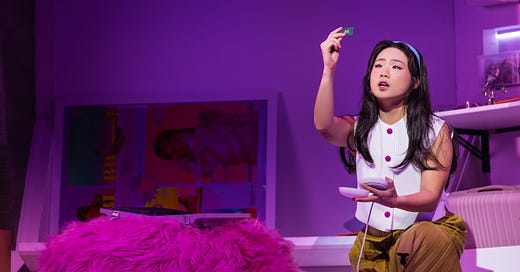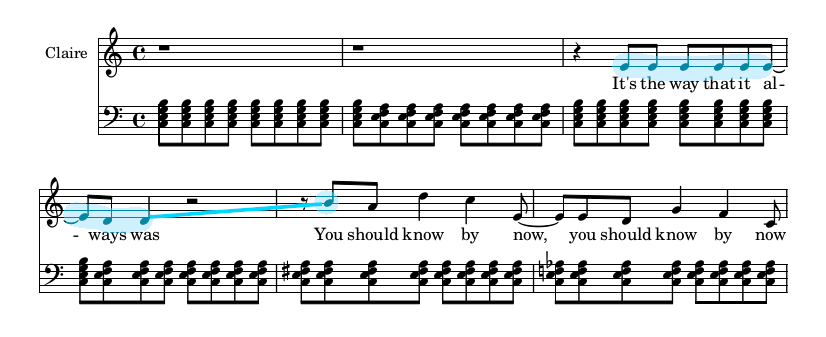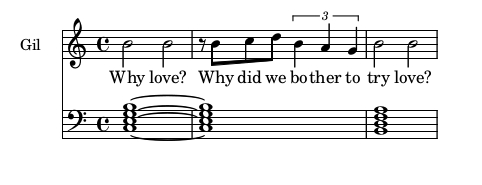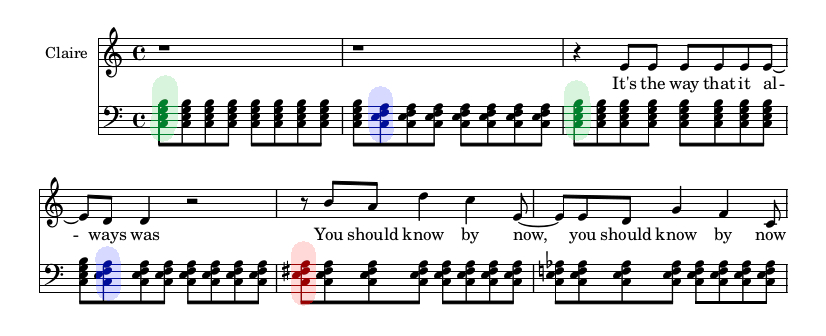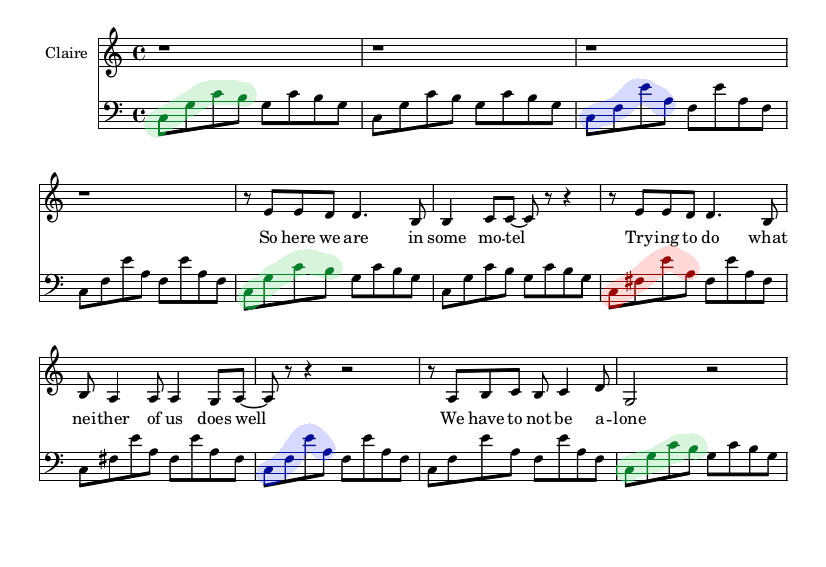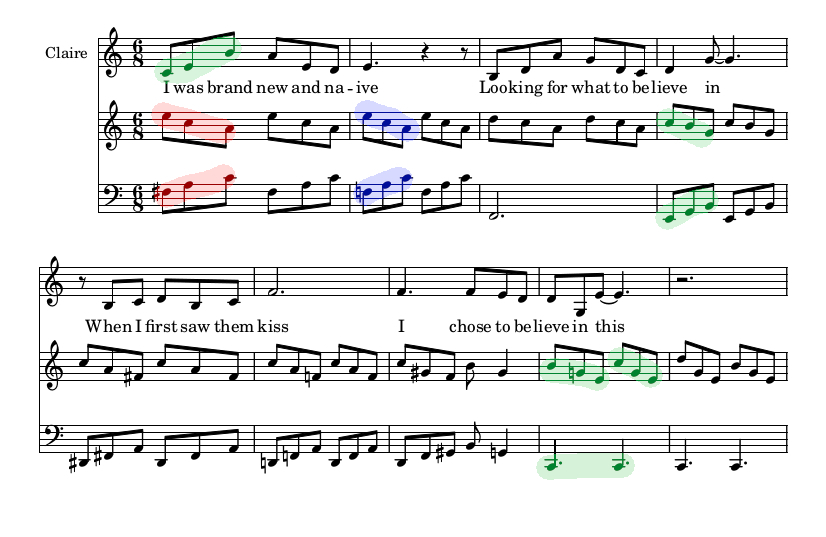Maybe Happy Ending: The Claire Chord
I recently published a post discussing some of the dramatic elements of the musical Maybe Happy Ending. I wanted to follow that up today with a post about a little musical detail in the score which I noticed, and which I have decided to dub “The Claire Chord.”
The character of Claire is given three solos in the musical. The first two, “The Way That It Has To Be” and “How To Be Not Alone” are built on the same initial theme.
Melodically, that’s plain enough. Both open with a simple melodic motif, first walking from the third scale degree down to the second, setting setting up a trajectory with a very strong expectation of a resolution on the tonic. But instead, she jumps to the seventh scale degree, dancing around the tonic before resolving. In “The Way That It Has To Be,” Claire jumps up the octave and works her way back down to the root in a series of scattered jumps, reflecting the song’s jittery anxiety as Claire attempts to repair or replace her broken charger. In “How To Be Not Alone,” a more at-rest moment for Claire, she slips down to the seventh and immediately resolves up to the root. She then repeats that phrase, and expands it into unresolved territory, reflecting the more exploratory mood as Claire examines and contemplates her situation.
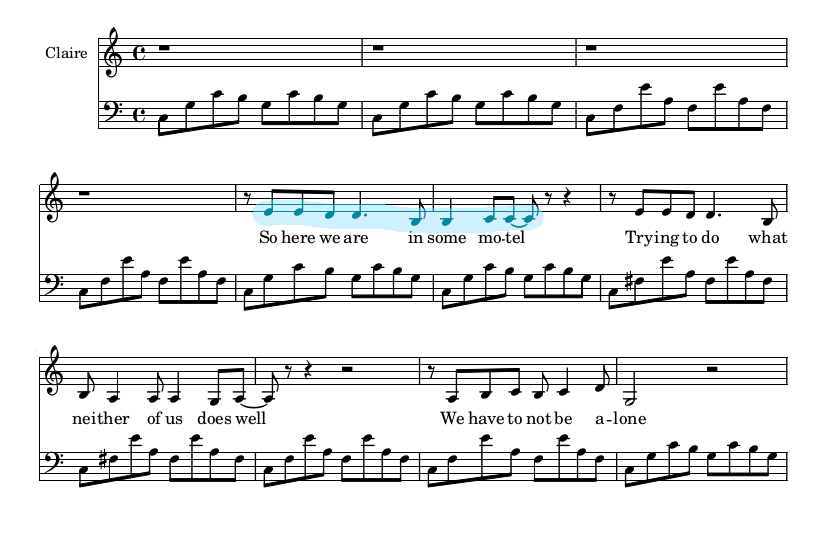
In terms of the harmony, both songs are built on a series of seventh chords, beginning with the I7 chord. The I7 chord is a prominent feature of Maybe Happy Ending’s score, with many of the melodies throughout the show outlining it in some form, and frequently emphasizing the seventh scale degree. This begins with the very first song, which has its melody start on the seventh scale degree sung over a I7 chord:
The very next song too begins with Oliver simply walking down a I7 arpeggio, beginning on the seventh scale degree:
“Goodbye My Room” sits prominently on the seventh scale degree for a few bars:
And the title song features a prominent leap to the seventh scale degree, in a melodic figure that resembles Claire’s from “The Way That It Has To Be”:
I have heard people describe the score of Maybe Happy Ending as “Sondheim-esque.” It may be that part of what they are hearing is the emphasis on the I7 chord, which musical theater kids might know more familiarly as the Into The Woods chord, being the chord that is relentlessly pounded in the iconic opening to that musical. So is it relentlessly pounded in Claire’s first solo:
The vamp preceding the song alternates pounding staccato I7 and IV7 chords. When the melody begins, the progression goes I7 - IV7 - [Claire Chord] - iv7. The “Claire Chord” is a half-diminished seventh chord built on a raised fourth scale degree. The progression is one of increasing dissonance and tension, reflecting the anxiety of the song.
Claire’s next solo, “How To Be Not Alone”, also begins with a vamp alternating I7 and IV7 chords, this time broken down into an arpeggiated figure:
The broken arpeggios convey a sort of deconstructed version of the harmony. This is a song in which Claire is processing and analyzing information, which is reflected in the deconstruction of the chords. When the melody kicks in, the progression is I7 - [Claire Chord] - IV7 - I7. Now, instead of the tension increasing over the course of the progression, Claire starts by jumping to the most dissonant chords, and then reverses course, easing off back into the resolved I7 chord. Even so, at the end of the song, the accompaniment wavers, alternating between the I7 and the unsettled Claire Chord.
Claire’s third solo, “What I Learned From People,” turns the whole thing on its head:
The melody kicks off with Claire outlining a I7 arpeggio, but the accompaniment starts right in with the dissonant Claire Chord, presented as a combination of two arpeggios played against each other to form the complete chord, combining elements of both previous songs. The accompaniment then progresses in reverse, going from the Claire Chord to the IV7, and then passing through a ii7 chord to get to the I7. But rather than resolving there, the harmony progresses to a fully diminished seventh chord in the next bar, and continues to spin off into further removed harmonic areas, eventually cycling back to the I7.
Note that in this song, the tonal center is kept somewhat vague, hovering between D Major, and its relative minor of B. (As transcribed above, C Major and A minor.) Because of this, what I have described as a I7 chord could in this song be described as a III7 chord. The notes are the same relative to each other, but it is contextualized differently in the overarching harmony, and made less stable, as is appropriate for the dramatic function of the song.
By building all three of Claire’s solos around different arrangements of the same three chords, Maybe Happy Ending achieves a musical unity and a distinct harmonic character. It is “Sondheim-esque” in the sense of subsequent songs not only reusing musical material from earlier songs, but building on them and developing them in new ways. This is a particularly subtle example of such a device, but certainly has an effect in contributing to the dramatic effectiveness of the musical’s score.

